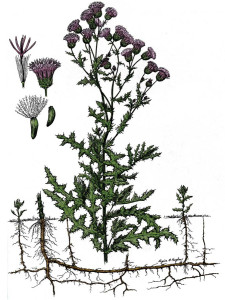NP Heille, Spring 2014
On this page:
Weeds in our garden
Quackgrass (Elymus Repens) also called twitch grass, quick grass, quitch grass, dog grass, scutch grass, and witchgrass. Quackgrass is native to Europe and Western Asia. It is thought to have moved from its centre of origin when it became a weed in cereal crops and then followed man’s movement around the world. For the world farmer of today it is often considered one of the most serious weeds because it infests 37 different crops in 65 countries.
This perennial can be difficult to control. When you dig in the garden you can recognize it by its prolific white rhizome root system.. As you dig and leave the white rhizomes behind it is well to remember the it grows from its rhizomes.
After Canadian thistle, this is your biggest weed to worry about. Unless managed it will suck up all the extra moisture in the ground that is needed for your cultivated veggies.
Canada thistle(Cirsium Arvense) also called Canadian thistle, creeping thistle, small-flowered thistle, green thistle. Despite its Canadian name it is native to the Mediterranean region and southeast Europe. You’ll need a tough pair of gloves to pull prickly Canada thistle from your garden.
With its rhizomes, it is difficult to control this perennial. Several gardeners reported getting control of Canada thistle by chopping down the plant before it went to seed and then pouring vinegar, salt, or a mixture of vinegar and salt water down the stem area. Repeat this process until you exhaust the roots. Vinegar is a broad-spectrum herbicide, and even though it’s water-soluble and will wash away after a heavy rain, avoid spraying it on weeds on windy days or pouring it right next to crops, or you could harm them. See “WEEDS – advice on how to control” near the end of this monograph for more on vinegar and other organic herbicides).
Many found success using a fork or narrow shovel to dig deep around the plants (target the mother plant, which is generally taller than others nearby), getting the whole root system, because any root fragments left in the ground will sprout into more plants. Do this when the ground is saturated so the roots will be easier to separate from the soil. Like the other weeds, it is critical to control Canada thistle when it first appears is crucial. Neglect it, and you will soon have a serious problem.
Purslane(Portulaca Oleracea) also known as verdolaga, pigweed, little hogweed, or pursley. There are 90 varieties that include the cultivar moss rose.
This annual grows flat on the ground and has small flat succulent oval leaves that radiate out on stems from a central root stem. It is native to Middle East and the Indian subcontinent of Malesia to Australasia.
While purslane is an exotic plant in North America, and is edible, you may find it more of a challenge to keep it under control so the seed crops like leaf lettuce will thrive.
Lambsquarters(Chenopodium album) refers to various edible species of goosefoot, or pigweed. Its native range is obscure due to extensive cultivation, but includes most of Europe, from where Swedish botanist Linnaeus described the species in 1753.
The first leaves to appear of the lambsquarters, usual four in count, have the shape of miniature cabbage leaves which lay close to the ground.
This perennial is edible. The genus Chenopodium contains several plants of minor to moderate importance as food crops and leaf vegetables – used like the closely related spinach (Spinacia oleracea) and similar plants called quelite in Mexico – and pseudocereals. These include white goosefoot (C. album), kañiwa (C. pallidicaule) and quinoa (C. quinoa). Amongst early North Americans inhabitants, the lambsquarters was used for food.
Ground Ivy(Glechoma Hederacea) also called gill-over-the-ground, creeping charlie, alehoof, tunhoof, catsfoot, field balm, run-away-robin, creeping jenny, and dollar weed.
This perennial is easy to recognize in your garden and lawn by the blue flowers it has in the spring and early summer. It grows flat on the ground. When you roll the stem between your fingers, you will find it square a characteristic of members of the mint family. Sometimes when it is cut there is a faint mint smell.
It was introduced into North America as an ornamental or medicinal plant, as early as the 1800s. Note: While it has been used in salads the USDA has found it is toxic to many vertebrates, including horses, if eaten in large quantities either fresh or in hay.
Dandelions(Taraxacum) Before any dandelion lovers get up in arms about this perennial plant as a weed let us fully acknowledge its benefits. Many enjoy dandelion’s tender young leaves for salad greens, flowers for wine, roots for flavoring herbal vinegar, roasted roots for a coffee substitute, etc. Some feed dandelions to their rabbits, chickens, ducks and geese, or let their flowers serve as food for bees and other beneficial insects.
If you are weary of this perennial’s beneficial qualities, to control them, dig out their taproot and remember that it can extend more than a foot into the ground. In the spring pick flowers before the seeds float all over your garden.
Controlling Weeds
Smother. Gardeners reported success with mulches that range from straw, boards, to newspaper.
Organic Herbicides. Many gardeners considered vinegar an effective herbicide option if applied directly to weeds on a sunny day. If you wish to protect the soil food ecology in your garden, note vinegar can do minor harm to soil microorganisms.
Top-rated organic Herbicides as used by gardeners (percent)
- Vinegar (72 percent)
- Herbicidal soap (68 percent)
- Neem oil (57 percent)
- BurnOut Weed & Grass Killer (42 percent)
- Weed Prevention Plus (29 percent)
- Weed Pharm Organic Weed Killer (23 percent)
- Cinnamon bark crab grass killer (17 percent)
References
Majority of advice and images for this guide from a Mother Earth News magazine website article “The 10 Worst Garden Weeds” selected by votes from more than 2,000 gardeners.





